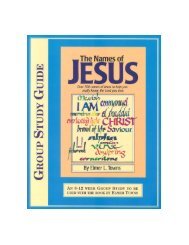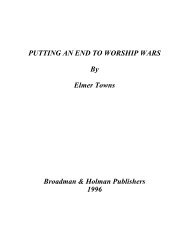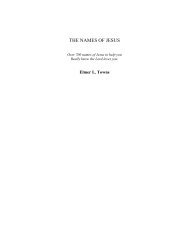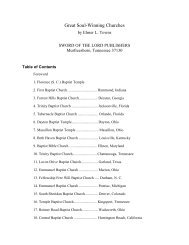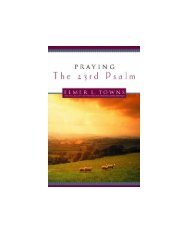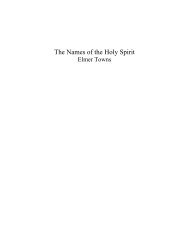A Journey Through The Old Testament - Elmer Towns
A Journey Through The Old Testament - Elmer Towns
A Journey Through The Old Testament - Elmer Towns
Create successful ePaper yourself
Turn your PDF publications into a flip-book with our unique Google optimized e-Paper software.
Damascus (cf. 15:2-3). When Abram arrived in Canaan, he continued traveling south until he<br />
came to Shechem.<br />
EXPRESSING FAITH AMONG THE CANAANITES<br />
(Gen. 12:6-8)<br />
Abram’s first stop in Canaan was near Shechem at a landmark identified as “the terebinth<br />
tree of Moreh” (Gen. 12:6). This tree was apparently a significant local landmark, probably a<br />
particular oak tree used in some kind of pagan worship. <strong>The</strong> difficulty in specifically identifying<br />
the particular kind of tree is evidenced in the varieties of oaks present in Israel. <strong>The</strong> Hebrew<br />
word alon is used to identify as many as nine species of oak and as many as twelve other subvarieties.<br />
<strong>The</strong>se are among the largest trees in the region which is probably why they were<br />
chosen as shrines for the worship of pagan deities.<br />
Identified simply as alon Moreh, some identify this tree as belonging to a man named<br />
Moreh. <strong>The</strong> name Moreh has been translated “teacher” or “soothsayer” and it may have been the<br />
name was really a title for the priest of some local Canaanite cult. If this is true, it is interesting<br />
to note that God revealed Himself to Abram and promised him the land of the Canaanites at the<br />
very place where they would come to worship them false god and perhaps practice divination in<br />
an effort to determine the will of their gods. Abram’s faith in God was in this way demonstrated<br />
to be more effective than the pagan worship of his neighbors.<br />
When Abram arrived, the Scripture notes, “And the Canaanites were then in the land” (v.<br />
6). Some five centuries would pass before the descendants of Abram would under Joshua<br />
conquer the Canaanites and take the land God had given them: <strong>The</strong> presence of the Canaanites<br />
was yet another test of Abram’s faith. God promised to give his descendants an alreadypossessed<br />
land. To make matters even worse, from all appearances the cursed Canaanites seemed<br />
to be better off than the blessed Abram. For one who had been raised in Ur and had lived in<br />
Haran, the lifestyle of a bedouin shepherd must have at times seemed less attractive than that of<br />
city dwellers in Canaan. This may be one reason why Lot eventually abandoned his tents for a<br />
home in Sodom (14:12).<br />
<strong>The</strong> Canaanites were the descendants of Canaan, the cursed grandson of Noah. Following<br />
the dispersion after the Tower of Babel, the Canaanites came to settle in the general region<br />
between the Jordan River and the Mediterranean Sea. When Joshua conquered the Canaanites<br />
and occupied the “Promised Land,” he carried out the curse on Canaan, son of Ham. He was<br />
made a servant at that time. <strong>The</strong> religious attitudes of the Canaanites centered around the worship<br />
of Baal and a hierarchy of gods including one called El.<br />
<strong>The</strong> El of the Canaanites was not the same god as the Elohim of the <strong>Old</strong> <strong>Testament</strong> which<br />
is sometimes abbreviated El. <strong>The</strong> worship of the Canaanite El involved human sacrifice, usually<br />
children, though sometimes adults, whereas the worship of God in the <strong>Old</strong> <strong>Testament</strong> forbade<br />
human sacrifice. When Abram “built an altar to the Lord, who had appeared to him” (12:7), he<br />
was worshiping the God whose attributes included justice (18:25), righteousness (v. 19), grace<br />
(19:19), wisdom (20:6), mercy (v. 6) and faithfulness (24:27). No pagan deity in Canaan ever<br />
possessed so high a moral character.<br />
<strong>The</strong> worship of God in Abram’s life normally involved the building of an altar. <strong>The</strong> verb<br />
translated “built” is a form of banah which was usually reserved for the building of something<br />
out of stone blocks. In this way Abram was demonstrating his faith differed from the Babylonian<br />
worship of the moon god Nauna(r)-Sin. In Babylon, altars were made of baked or unbaked<br />
bricks. In Canaan, two kinds of altars were built, the altar of earth and the altar of stone (cf. Ex.




